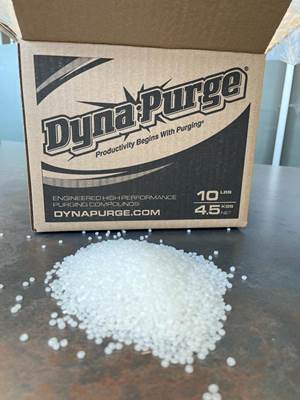Compounders: Now You Can Monitor Color Inside the Extruder!
If you're compounding colors, there's no need to keep running pellet samples to the lab for periodic quality checks.
If you're compounding colors, there's no need to keep running pellet samples to the lab for periodic quality checks. Instead, a fiber-optic probe inside the extruder die connected to a spectrophotometer with a CCD sensor outside the extruder provides the first commercial system for real-time, on-line monitoring of color in the melt stream. It can eliminate the costly, labor-intensive practice of molding color plaques from pellets for quality checks.
The new Equispec OCS (Online Color Spectrophotometer) comes from Equitech International Corp., a 10-year-old company that is making its first foray into the plastics market. It supplies fiber-optic spectroscopic instruments for process analysis by pharmaceutical and chemical manufacturers.
How it works
Whereas conventional laboratory spectrophotometers utilize diode arrays as the color detector and are limited to analysis of solid or liquid samples at room temperature, Equispec OCS uses CCD (charge-coupled device), or video camera technology, that looks into the melt through a fiber-optic cable. A lamp within the analyzer transmits light via the fiber-optic probe to illuminate the melt stream. Light is reflected or transmitted back to the analyzer via one or more other optical fibers at the tip of the probe. The company's Reflection Polymer Melt Probe for opaque materials and its Transmission Polymer Melt Probe for clear or translucent melts can withstand the conditions inside an extruder. Their sapphire windows can take up to 370 C (700 F) and 5000 psi. Both of the probes can be mount ed in one flange at a pressure port that is available in most extruder dies.
According to Equitech executive v.p. Dr. Jaime Gomez, the CCD is much more sensitive than a diode array, and it can capture a signal with very little illumination—such as inside an operating extruder. CCDs not only can measure color by conventional absorbance measurements but also can measure fluorescence at extremely low intensity levels.
The reflection probe consists of seven illuminating fibers evenly spaced around the probe circumference. Illumination fibers are angled at 28° from the surface. The reflected light is picked up by a single fiber at 0° from the surface. The transmission probe consists of an illumination fiber, a detection fiber, and a sapphire optical element. The light passes from the illumination fiber through a slot in the probe's sapphire tip into the detection probe. The path length of the probe is 1.5 mm.
Another advantage of this instrument is that the CCD technology provides the spectrophotometer with four fiber-optic inputs that allow users to monitor two production lines simultaneously with a single instrument. "You have two double-beam spectrophotometers for the price of one," says Gomez. The Equispec OCS with one fiber-optic probe sells for roughly $40,000. He adds that monitoring two extruders simultaneously would not be possible with diode-array spectrophotometer.
In addition, CCD technology produces a more precise spectral curve of color measurements, since the instrument is capable of reporting data at intervals of 0.75 nm (nanometer) vs. 5 to 10 nm for a typical spectrophotometer.
The OCS instrument does not require daily calibration since one of the internal channels is always used for the reference, thus correcting for any electronics drift. EquiColor, the instrument's Windows-based software monitors real-time L*,a*,b*, and delta E values and allows users to save standards and tolerances for each product, so production parameters for a particular color lot can be recalled at any time.
Other QC applications
One of Equitech's specialties is creating probes for all types of situations. For instance, it offers a non-contact, large-area probe that can be used for on-line monitoring of the color of extruded products like vinyl siding immediately after they exit the die.
Related Content
Multilayer Solutions to Challenges in Blow Molding with PCR
For extrusion blow molders, challenges of price and availability of postconsumer recycled resins can be addressed with a variety of multilayer technologies, which also offer solutions to issues with color, processability, mechanical properties and chemical migration in PCR materials.
Read MoreChroma Color ChromaXLPEUltra Color Concentrates for Cross-Linked Polyethylene
Concentrates are designed to provide vibrant color while upholding material properties and meeting regulatory standards.
Read More'Dual Action' Purging Compound Accelerates Color Changes
NPE2024: Shuman Plastics’ Dyna-Purge Division launches Dyna-Purge L, extending its “3X technology.”
Read MoreTechmer Buys Advanced Color Technologies
Deal will expand Techmer’s in colorants and additives in synthetic fibers.
Read MoreRead Next
People 4.0 – How to Get Buy-In from Your Staff for Industry 4.0 Systems
Implementing a production monitoring system as the foundation of a ‘smart factory’ is about integrating people with new technology as much as it is about integrating machines and computers. Here are tips from a company that has gone through the process.
Read MoreBeyond Prototypes: 8 Ways the Plastics Industry Is Using 3D Printing
Plastics processors are finding applications for 3D printing around the plant and across the supply chain. Here are 8 examples to look for at NPE2024.
Read MoreSee Recyclers Close the Loop on Trade Show Production Scrap at NPE2024
A collaboration between show organizer PLASTICS, recycler CPR and size reduction experts WEIMA and Conair recovered and recycled all production scrap at NPE2024.
Read More










